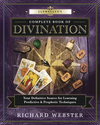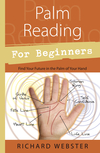Your Potential Is Written in Your Palm

When I was ten years old, a chance meeting changed my life forever. I made friends with a middle-aged woman who lived a few houses away. She was an excellent cook, and I regularly visited her, motivated at least partly by her cakes and cookies. She and her husband were childless, and I think she enjoyed regular visits from a small boy who loved sweet foods as much as she did. I was a keen reader, and was fascinated that they had a library room in their home. One day, while browsing through their library, I found a section of books on palmistry. She told me her husband was a palmist, and when he came home, he told me something about the subject. Amused at my interest, he started teaching me the basics of palmistry, and gradually his lessons became more important than the cakes and scones his wife always produced.
It's possible I was the only person he could discuss palmistry with, as fortune telling was illegal in New Zealand at that time. He read palms professionally, but because of the law, had to do it secretly. I used to go to school and look at the palms of friends, but didn't take it seriously until I was a teenager and discovered what a wonderful way it was to meet girls. When I was twenty, I moved to London. It was hard making ends meet working in a bookstore, but in a matter of weeks I'd doubled my income by reading palms in my spare time. I've since made my living in several different countries, largely thanks to the couple I met when I was a child. It's always fascinated me how a chance encounter can change someone's life. If my parents hadn't moved house when they did, or if I hadn't made friends with the wife of a palmist, I may never have discovered palmistry.
In the early 1980s, I started reading palms in shopping malls. The readings were extremely popular, and I always had a line of people waiting to see me. Unfortunately, the readings had to be brief, and this meant I didn't have time to discuss the many talents and skills that were indicated in the palms I saw. I told myself that one day I'd write a book about them. It's taken thirty-five years, and I'm very happy that Potential in the Palm of Your Hand is now available.
People have always been interested in the human hand; this fact is illustrated by the many palm prints that can be found in prehistoric cave drawings. Some 2,500 years ago, Aristotle included information on palmistry in one of his books. Palmistry is mentioned four times in the Bible. Although palmistry was practiced in India and China at least three thousand years ago, it wasn't until the late Middle Ages that it became popular in Europe. Books on palmistry became available shortly after movable type was introduced in 1450. These books all focused on the fortune-telling aspects of palmistry. Paracelsus, the sixteenth century physician and alchemist, was hundreds of years ahead of his time, as he used palmistry for medical diagnostic purposes. It took until the nineteenth century for palmists to start considering palmistry could be used for purposes other than fortune-telling. In the nineteenth century, a French palmist called Stanilas d'Arpentigny noticed that hands could be classified into different types, and that these revealed a great deal about the interests and personalities of the people the hands belonged to. Katharine St. Hill, an English palmist, included information on how to determine suitable careers by examining people's hands in The Book of the Hand, published in 1927. Other authors, notably an American palmist called William G. Benham, began investigating this aspect of palmistry in much greater depth, and in the 1940s, palmists started looking at people's hands from a psychological point of view. Palmists today read hands for many reasons, and one of the most important of these is to reveal people's talents and skills.
Some potentials can be seen at a glance. Someone with a pronounced angle formed where the outside of the thumb joins the palm is dexterous and good with his or her hands. Not surprisingly, this angle is called the angle of practicality. Whenever I need a plumber or an electrician, I choose someone with a pronounced angle of practicality, as I know he or she will be able to do the job. This angle is sometimes called the angle of time. This can indicate punctuality, but also gives entertainers a good sense of timing.
The angle of pitch is located at the base of the palm below the thumb where it joins the wrist. This gives the person a good ear for music, as well as a strong sense of rhythm. Good musicians, dancers, and singers usually possess both the angle of practicality and the angle of pitch. The angle of practicality gives them good timing, and the angle of pitch gives them a keen ear for music and a sense of rhythm. Both of these angles can be clearly seen in photographs of Elvis Presley's hands.
Someone with a thumb that is long compared to the rest of the hand will be motivated, persistent, and ambitious. This gives the person leadership qualities.
Someone with long fingers will be patient and pay attention to detail. These are qualities you'll want your accountant and bank manager to have. Someone with short fingers will be more interested in the overall picture, rather than the details. This person enjoys being busy, and often tries to do several things simultaneously. In the days where people lined up in front of individual tellers in the bank, I always chose the line in front of someone with short fingers, as I knew this person would attend to each customer as quickly as possible. The tellers with long fingers would check and recheck everything several times to make sure it was right. Consequently, their lines moved more slowly than those of the short-fingered tellers.
According to the 2017 Gallup State of the Workplace study, only a third of American workers enjoy their work. Fifty-one percent were disengaged, and sixteen percent were "actively disengaged," which means they disliked or even hated their jobs. Can you imagine how much happier the world would be if the almost seventy percent of people who aren't happy in their work found jobs that utilized their skills, knowledge, and interests?
In the late nineteenth century, palmists started examining people's hands to determine their natural talents and enable them to choose satisfying and rewarding careers. As this study shows, more than a hundred years later, few people use palmistry, or any other method, to choose their ideal career. A palmist cannot indicate a specific occupation, but is able to point out the talents and abilities that need to be utilized for the person to enjoy a happy and successful career.
It's amazing how many people aren't aware of, or aren't using, the talents or potential with which they were born. Helping people discover these is one of the most valuable things you could possibly do for them. It's also incredibly satisfying. With the information in Potential in the Palm of Your Hand, you'll be able to use palmistry to see the potentials that are clearly revealed in your own hands, as well as those of your loved ones and friends.

About Richard Webster
Related Products



is subject to certain Terms and Conditions